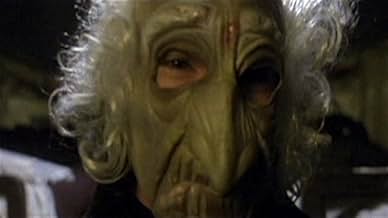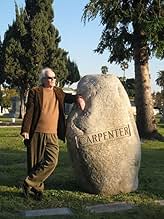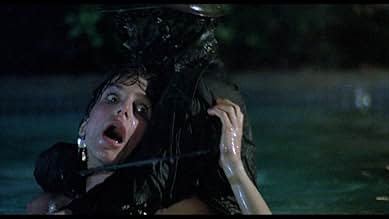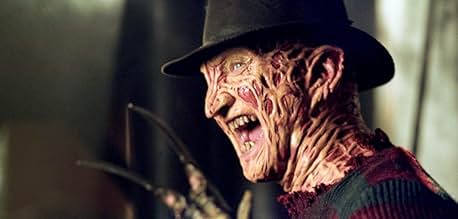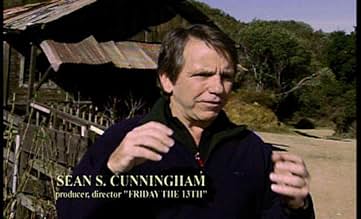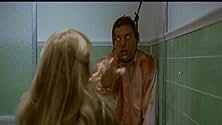NOTE IMDb
7,2/10
3,7 k
MA NOTE
Ajouter une intrigue dans votre langueA documentary on the history of the slasher film.A documentary on the history of the slasher film.A documentary on the history of the slasher film.
- Réalisation
- Scénario
- Casting principal
Amy Holden Jones
- Self
- (as Amy Holden-Jones)
Anthony Timpone
- Self
- (as Tony Timpone)
Avis à la une
I'm a little impressed. Whether the credit belongs to director Jeff McQueen, producers Rachel Belofsky and Rudy Scalese, or the writers, this is a more meaningful, thoughtful documentary than I supposed it was going to be. I'm not saying that it's perfect, because there are embellishments here and there (music cues, title cards) that are a bit gauche, and the enthusiasm and anecdotes that some interviewees share are a bit much at times. Then again, that enthusiasm really speaks to how much fun everyone had making these movies, the passion they have for the underlying craft, and the thrill of the visceral storytelling. The feature earnestly covers a lot of ground: the violent thrillers from which slashers took influence; the art of illusion behind practical effects like blood and gore; discussion of where slashers fit into society and culture, and how they may or may not reflect that society and culture; the push to make movies that exploited every possible holiday and occasion, and every possible weapon of choice; and more. From producers and directors to effects artists and stars, we're greeted with a slew of interview subjects who offer their own perspective on the genre, with focus primarily on the golden age of the slasher from their inauguration with John Carpenter's 'Halloween' in 1978, to the early and mid 80s when slashers had more or less become the new "it" girl of horror. There is nothing in 'Going to pieces' that's a particular revelation, yet the picture gives welcome, broad perspective - or rather, retrospective - that's more sincere and ruminative than I'd have guessed before I sat to watch.
Some films get more emphasis than others, and not unreasonably; 'Halloween' began it all, 'Friday the 13th' raised the bar with crimson and viscera, and 'A nightmare on Elm Street' took things in a wild new direction. If only in passing, though, this touches upon even more flicks than I've seen, and some I'd never even heard of. Along the way, there's an early spotlight on the conventions that largely define slashers, including settings, protagonists, antagonists, murder weapons, and more - and with this in mind, one place where I think the title falters is in failing to identify how easily the genre became very formulaic, and very stale, very quickly. True, there are still many viewers who flock to slashers for the cavalcade of random violence and death, but I think there came a point where slashers became dull unless there is either some major point of brilliance to help it stand out, or some new twist on the style (e.g., 2015's 'The final girls') that really upended norms. In some measure 'The rise and fall of the slasher film' also raises reasonable questions: of what specifically defines the "slasher"; if every piece mentioned herein really is a slasher or just falls into "horror" generally, or some other subgenre; the extent to which slashers may have had influence elsewhere in horror; and ultimately how accurate the name even is, if slashers continue to be a major force in horror cinema. The documentary really does cover a lot of ground, but it could have broadened its scope even more, and despite the name it's worth observing that there's not so much a central thesis here as an overarching idea of examining the genre.
There are notions touched upon in passing that could have been explored even more deeply: the regressive, conservative values that seemingly inform killers in movies; the triumph of "the final girl" as a representation of feminism; the outdated, harmful language and ideas that "other" and demonize a subset of the population by setting up a particular type of figure as the killer (i.e., lots of ableism, homophobia, and transphobia); and so on. In fairness, to whatever extent 'Going to pieces' could have done more, maybe these were also beyond its purview, for the chief intent here was in a sort of history of the genre (as of 2006), and if imperfectly, I think it does that job very well. Whether one is a fan of slashers, or of documentaries, or just an avid cinephile at large, I think there's much to appreciate here for a lot of folks. All told it may not be something one needs to go out of their way to see, but for something light yet interesting, 'Going to pieces' is a fine movie that's well worth checking out if you have the chance.
Some films get more emphasis than others, and not unreasonably; 'Halloween' began it all, 'Friday the 13th' raised the bar with crimson and viscera, and 'A nightmare on Elm Street' took things in a wild new direction. If only in passing, though, this touches upon even more flicks than I've seen, and some I'd never even heard of. Along the way, there's an early spotlight on the conventions that largely define slashers, including settings, protagonists, antagonists, murder weapons, and more - and with this in mind, one place where I think the title falters is in failing to identify how easily the genre became very formulaic, and very stale, very quickly. True, there are still many viewers who flock to slashers for the cavalcade of random violence and death, but I think there came a point where slashers became dull unless there is either some major point of brilliance to help it stand out, or some new twist on the style (e.g., 2015's 'The final girls') that really upended norms. In some measure 'The rise and fall of the slasher film' also raises reasonable questions: of what specifically defines the "slasher"; if every piece mentioned herein really is a slasher or just falls into "horror" generally, or some other subgenre; the extent to which slashers may have had influence elsewhere in horror; and ultimately how accurate the name even is, if slashers continue to be a major force in horror cinema. The documentary really does cover a lot of ground, but it could have broadened its scope even more, and despite the name it's worth observing that there's not so much a central thesis here as an overarching idea of examining the genre.
There are notions touched upon in passing that could have been explored even more deeply: the regressive, conservative values that seemingly inform killers in movies; the triumph of "the final girl" as a representation of feminism; the outdated, harmful language and ideas that "other" and demonize a subset of the population by setting up a particular type of figure as the killer (i.e., lots of ableism, homophobia, and transphobia); and so on. In fairness, to whatever extent 'Going to pieces' could have done more, maybe these were also beyond its purview, for the chief intent here was in a sort of history of the genre (as of 2006), and if imperfectly, I think it does that job very well. Whether one is a fan of slashers, or of documentaries, or just an avid cinephile at large, I think there's much to appreciate here for a lot of folks. All told it may not be something one needs to go out of their way to see, but for something light yet interesting, 'Going to pieces' is a fine movie that's well worth checking out if you have the chance.
This is pretty much what you'd expect from the title: a group of actors, directors and special effects people talk about the slasher genre of the early 1980s. They cover all the big ones, some of the lesser ones, and go over the backgrounds.
How did the Italian films of Mario Bava influence the slashers? Are they anti-woman? Do they make kids do bad things? Is it a dead genre? All of this is covered and more... such as the concept of the "final girl" and other tropes so often found in horror.
I would have liked a bit more history, and maybe more credit given to Bob Clark and "Black Christmas" (which, to me, deserves more recognition than John Carpenter's "Halloween"). But I can't really complain with all these people they found to interview -- getting Carpenter, Craven, Rob Zombie and more to appear on film? Well done.
I have met the man who wrote the book this film is based on, the charming Adam Rockoff. If this film was your idea of education, get his book! Much more than you can cram into a 90-minute film.
How did the Italian films of Mario Bava influence the slashers? Are they anti-woman? Do they make kids do bad things? Is it a dead genre? All of this is covered and more... such as the concept of the "final girl" and other tropes so often found in horror.
I would have liked a bit more history, and maybe more credit given to Bob Clark and "Black Christmas" (which, to me, deserves more recognition than John Carpenter's "Halloween"). But I can't really complain with all these people they found to interview -- getting Carpenter, Craven, Rob Zombie and more to appear on film? Well done.
I have met the man who wrote the book this film is based on, the charming Adam Rockoff. If this film was your idea of education, get his book! Much more than you can cram into a 90-minute film.
GOING TO PIECES is a fun reflection on the slasher genre, primarily exploring the wave of American slasher flicks that came out since the success of Carpenter's HALLOWEEN in 1978. Other influences such as Argento and Bava are only mentioned in passing, and there are some notable omissions (what about BLACK Christmas?) but for the most part this is a fun and in-depth look at a much-maligned sub-genre of film.
Obviously, the documentary is awash with clips that take up about two-thirds of the running time. Most of these focus on the goriest of the kill scenes in each film, so if that's your bag then you'll enjoy yourself. However, in addition, we get interviews with tons of guys involved with the production of these movies; writers, producers, directors, occasionally stars. You'd expect to see Carpenter and Savini here, but I appreciated the less well-known faces too. GOING TO PIECES is a great watch for anyone with even a minor interest in the slasher genre.
Obviously, the documentary is awash with clips that take up about two-thirds of the running time. Most of these focus on the goriest of the kill scenes in each film, so if that's your bag then you'll enjoy yourself. However, in addition, we get interviews with tons of guys involved with the production of these movies; writers, producers, directors, occasionally stars. You'd expect to see Carpenter and Savini here, but I appreciated the less well-known faces too. GOING TO PIECES is a great watch for anyone with even a minor interest in the slasher genre.
The positive things about "Going To Pieces" are that it tries hard to include as many Slasher flicks as possible and deliver pieces of trivia for each of them. There are interviews with some influential directors of the genre (John Carpenter, Wes Craven, Sean Cunningham,...), actors, make-up guru Tom Savini and some "horror-experts".
For starters, this movie is a good introduction to the genre. Real fans will not find a lot of new information here. We all know about the influence of "Halloween", we've heard the story of how Freddy Krueger has been created, we know how Wes Craven revived the genre with "Scream". Sure, it's unfair to criticize that all this is being told again in a documentary like this. After all the story wouldn't be complete without this information, but in the end one can't learn too much from "Going To Pieces".
It would have been a real treat to learn the history of gore in movies, to learn about the influences for American slasher in detail. Instead we are only told about Italian horror in what seems like 2 minutes and then there's no further mention of it. "Halloween" is made out to be the first slasher movie, when even "Black Christmas" came before it in America. "Friday The 13th" is given more credit than it really deserves as an original movie. Make no mistake, I'm not trying to imply that those movies aren't very important to the genre, but it would have been a fresh approach to take a closer look at their origins.
Another thing to consider is that before "Going To Pieces" you should either make sure that you know all of the movies mentioned in the documentary or accept the fact that some great twist endings will be spoiled for you, some of which are the only reason to watch these flicks in the first place ("Sleepaway Camp", "Happy Birthday To Me").
In the end "Going To Pieces" will get you excited about watching old slasher flicks again (probably until you rent something like "Pieces" and realize the film is not half as exciting as it's made out to be in hindsight), but there are books out there that are a lot more informative than this documentary.
For starters, this movie is a good introduction to the genre. Real fans will not find a lot of new information here. We all know about the influence of "Halloween", we've heard the story of how Freddy Krueger has been created, we know how Wes Craven revived the genre with "Scream". Sure, it's unfair to criticize that all this is being told again in a documentary like this. After all the story wouldn't be complete without this information, but in the end one can't learn too much from "Going To Pieces".
It would have been a real treat to learn the history of gore in movies, to learn about the influences for American slasher in detail. Instead we are only told about Italian horror in what seems like 2 minutes and then there's no further mention of it. "Halloween" is made out to be the first slasher movie, when even "Black Christmas" came before it in America. "Friday The 13th" is given more credit than it really deserves as an original movie. Make no mistake, I'm not trying to imply that those movies aren't very important to the genre, but it would have been a fresh approach to take a closer look at their origins.
Another thing to consider is that before "Going To Pieces" you should either make sure that you know all of the movies mentioned in the documentary or accept the fact that some great twist endings will be spoiled for you, some of which are the only reason to watch these flicks in the first place ("Sleepaway Camp", "Happy Birthday To Me").
In the end "Going To Pieces" will get you excited about watching old slasher flicks again (probably until you rent something like "Pieces" and realize the film is not half as exciting as it's made out to be in hindsight), but there are books out there that are a lot more informative than this documentary.
This is a pretty good treatment of the thinking that went on behind the scenes of movies like "Prom Night", "Friday the 13th", "Nightmare on Elm Street", "Texas Chainsaw Massacre", and others. The great thing is that the cool stories and insights are told by the key players involved (directors, producers, special effects artists). You get to hear not only their thoughts on the psychology involved, but also about the marketing struggles they had to deal with.
Essentially, this is a documentary which interweaves present-day interviews with film clips from classic 80's horror flicks to give you a behind the scenes look at a genre during its peak period of interest. If you're a horror fan, you'll probably like watching this.
Essentially, this is a documentary which interweaves present-day interviews with film clips from classic 80's horror flicks to give you a behind the scenes look at a genre during its peak period of interest. If you're a horror fan, you'll probably like watching this.
Le saviez-vous
- AnecdotesExecutive Producer Michael Ruggerio had previously worked on The American Nightmare (2000), one of the documentaries that inspired Going To Pieces. He always said he wanted to do a sequel about the Slasher movies of the 1980's. He happened to be good friends with author Adam Rockoff. After producer Rudy Scalese optioned the book rights to Going to Pieces and befriended Adam Rockoff, Adam made an introduction to Ruggerio who was now an executive at STARZ and championed the documentary to be made.
- Citations
John Carpenter: New talents come along, old talents fade away.
- ConnexionsFeatures La Guerre des mondes (1953)
Meilleurs choix
Connectez-vous pour évaluer et suivre la liste de favoris afin de recevoir des recommandations personnalisées
- How long is Going to Pieces: The Rise and Fall of the Slasher Film?Alimenté par Alexa
Détails
- Date de sortie
- Pays d’origine
- Langue
- Aussi connu sous le nom de
- Going to Pieces - el éxito y la caída del cine de destazamiento
- Lieux de tournage
- Los Angeles, Californie, États-Unis(Hollywood Forever Cemetary)
- Sociétés de production
- Voir plus de crédits d'entreprise sur IMDbPro
Box-office
- Budget
- 600 000 $US (estimé)
Contribuer à cette page
Suggérer une modification ou ajouter du contenu manquant



